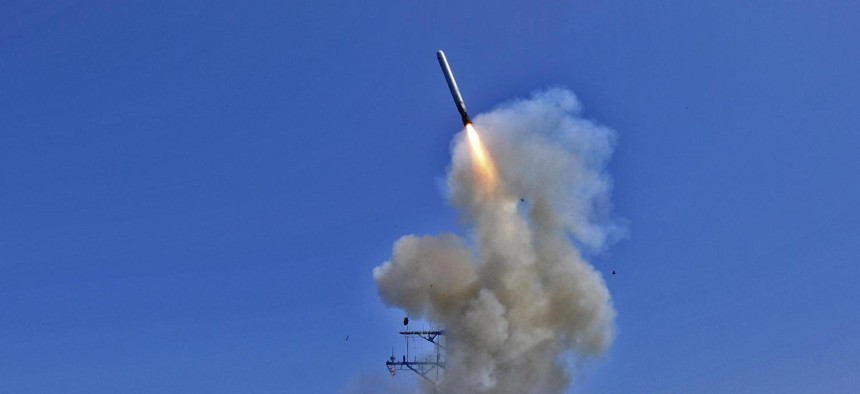How NORAD Plans to Ward Off Cruise Missiles Fired at the US

The Arleigh Burke-class guided-missile destroyer USS Barry launches a Tomahawk cruise missile from the ships bow. Barry is currently supporting Joint Task Force Odyssey Dawn. U.S. Navy photo by Petty Officer 3rd Class Jonathan Sunderman
The command has goals for 2025 and 2030, but wants more guidance from the Pentagon.
ASPEN, Colo. — Lawmakers who worry that the United States cannot ward off the kind of cruise missiles that Russia is lobbing at Ukraine should know that the Pentagon does have a plan to do so—in a few years. But the command in charge of that defense needs new technologies and updated guidance from higher-ups.
“We absolutely have a plan to defend from cruise missiles,” Gen. Glen D. VanHerck, the head of U.S Northern Command and North American Aerospace Defense Command, or NORAD, said, in a meeting with reporters during the Aspen Security Forum last week.
The largely classified plan focuses on 2025 and beyond, VanHerck said.
A big part of it is prioritizing defense around the targets that an adversary would most likely attack with cruise missiles, he said.
“We did analysis on what we thought would be key, critical infrastructure that we would have to defend. And when you plot them on a map, most of them fall in about eight or 10 key areas spread around the country. A lot of them are on the East Coast. So, wide-area defense systems, or limited-area defense systems, I think, are appealing for the future,” he said.
That “wide-area” defense could incorporate things like jamming, hacking, or other electronic warfare abilities. For limited area defense, NORAD could deploy fighter jets or its own cruise missiles to attack incoming missiles.
“We do have defensive capabilities in the National Capital Region and I do have NORAD fighters on alert at Andrews Air Force Base.…That is part of homeland defense design,” VanHerck said.
But defending the United States from all sorts of missiles is becoming increasingly complex and NORAD needs better sensors, satellites, radars, data tools, and more to see and track incoming threats, said VanHerck.
“The challenge becomes the domain awareness for those cruise missiles,” he said. “The North Warning System, which was put into place in the 1980s, did its job very well for the Soviet and the Russian threat of bombers coming over the [North] Pole. But now, as you develop a cruise missile with stealth characteristics, the radar coverage is shrunk. And so, imagine a solid fence shrinking to a picket fence. And now you have cruise missiles that can get through your capability to detect.”
“And so, cruise missiles can come off submarines in the Atlantic or in the Pacific, they can come off container ships parked in port, they can come off land, they can come off of airplanes, they can come off multiple directions from all axes. And so we need to be able to have domain awareness 360 degrees. We absolutely have a plan. It focuses on 2025, the homeland defense design, and then 2030 as we go forward.”
The key, classified details of the cruise-missile defense plan are codified in the latest versions of Concept Plan (CONPLAN) 3310, the Aerospace Warning, Aerospace Control & Maritime Warning forof North America;” and Operation Plan (OPLAN) 3400 Homeland Defense Plan, Capt. Alexandra Hejduk, a communication officer at NORAD, explained in a separate email.
NORAD also needs new artificial intelligence tools to help decide how to deal with threats, Brig. Gen. Paul Murray, NORAD’s deputy director of operations, said at a CSIS event earlier in July.
Once NORAD has those capabilities, the biggest challenge will be integrating them globally, Murray said.
“You need to bring in your other partners in whatever conflict,” he said. “There are things that maybe one of our partners like Australia can do in a forward conflict from a homeland defense perspective that would complement [U.S. capabilities] and there's things that we could do to complement theirs.”
Murray said NORAD also needs the Pentagon to identify exactly what sort of threats his command should tackle and where, and which ones it should leave to other agencies.
“We need policy on what to defend, i.e., the places that you want to defend in the United States,” he said. ”And then, what do you want to defend against?” as in, hypersonic cruise missiles, small or large drones, or other threats.
“The final big thing we learned, after we kind of studied this and the 2025 timeframe, is we need culture change,” Murray said. “We need an understanding, a common understanding, of the threat, the vulnerabilities to our homeland and that the homeland is no longer a sanctuary.”
But key to NORAD’s plans is making sure that adversaries know that the United States is working to cover the gaps in its homeland cruise missile defense and that an attack on the homeland is not a quick road to victory or surrender.
Said VanHerck: “Candidly, if I’m shooting down cruise missiles and ballistic missiles, we’ve failed in deterrence and that’s not where we want to be. So that’s where we’re really focused.”





